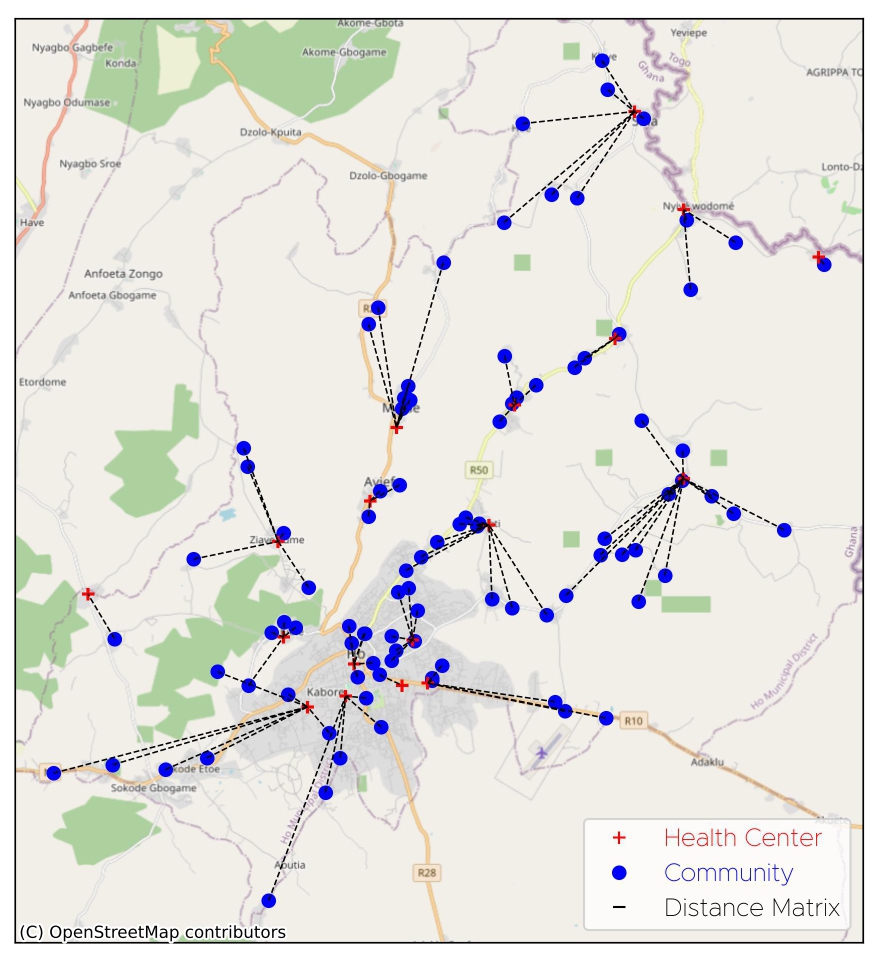
Problem:
Ho Municipal is home to a diverse population that includes both urban and rural communities. Unfortunately, many of these communities face significant barriers to accessing quality healthcare services. The problem is compounded by the fact that many healthcare facilities in the Municipality are concentrated in Ho, leaving rural communities with limited access to essential health services. This situation is in contravention of international regulations that state that access to essential healthcare services should be available to everyone, regardless of their geographical location or socioeconomic status.
Project Objective:
The objective of this project is to examine the current state of healthcare service delivery in Ho Municipal, with specific focus on the driving distances between the communities and their nearest health facilities. The study will explore the current distribution of healthcare facilities, including both public and private healthcare providers, and assess their accessibility for different communities.
Importance:
By ensuring equitable access to healthcare services in Ho Municipal, this project will help improve health outcomes and reduce health disparities among different communities. This is in line with the global health agenda, which seeks to promote universal health coverage and ensure that all people have access to quality healthcare services. The project's findings will be relevant not only to the current area of interest but also to other areas in Ghana and other low- and middle-income countries facing similar challenges.
Approach:
The analysis utilized two sets of vector data in ESRI shapefile format; Communities (Origins) and Health Facilities (Destinations). The GeoPandas Python library was used to access and preprocess the data, removing duplicates and inaccurate entries, and formatting the table headings.
To compute the distances between the Communities (Origins) and Health Facilities (Destinations), the Open Route Service's (ORS) Distance Matrix API was utilized. The API required a list of coordinate pairs in the WGS 84 format (longitude, latitude), which were obtained from the geometry columns of the GeoDataFrames, as well as a list of indices for the origins and destinations, using the index columns in each of the GeoDataFrames.
Following data preprocessing, a post request was made to the ORS Distance Matrix API with the required parameters. The output contained a list of distances from each community (origin) to each health facility (destination). The origin GeoDataFrame was then iterated over to extract the minimum distance and the coordinates of their associated destinations. The extracted destination coordinates were further used to retrieve the names of the destinations. A new GeoDataFrame was created using the variables generated from the previous computation, including origin name, origin latitude, origin longitude, destination name, destination latitude, destination longitude, and minimum distance. This was done to enable the construction of lines connecting each origin to its associated destination using the Shapely Python library.
Finally, the results of the analysis were displayed using visualization tools such as Matplotlib and Folium.
Results and Conclusion:
The analysis revealed some fascinating statistics regarding the minimum distances between each community and its associated healthcare facility. The data shows that the average minimum distance between each community and its associated healthcare facility is 2.88 km, with a standard deviation of 2.43 km. This means that, on average, the communities are within 2.88 km of the nearest health facility. The minimum distance between each origin and its associated destination is 0.02 km, which indicates that some communities are fortunate to have a health facility located very close to them. However, the maximum distance of 11.02 km suggests that some communities may be facing significant barriers in accessing healthcare services, as they have to travel long distances to get to the nearest health facility. This could lead to delays in treatment, increased health complications, and even mortality.
Additionally, the standard deviation of 2.43 km represents a significant variation in the minimum distances between communities and their associated health facilities. In fact, the standard deviation is 84% of the mean, indicating a wide spread of values around the average minimum distance.
These statistics have important implications for the World Health Organization's (WHO) standards and the Sustainable Development Goals (SDGs). The WHO recommends that healthcare services should be available within a maximum distance of 5 km from any community. The analysis revealed that a significant number of communities in the Municipality do not meet this standard, with some healthcare facilities located more than 10 km away from their associated communities. The SDGs aim to ensure that all people have access to quality healthcare services by 2030. While progress has been made towards this goal, there is still a significant amount of work to be done.
Overall, valuable insights have been provided into the accessibility and availability of healthcare services in the Ho Municipality. In addition, the assessment highlights areas that require attention to meet the WHO standards and SDG goals. By presenting the statistics in a clear and concise manner, the evaluation hopes to raise awareness of the importance of accessible and quality healthcare for all. It also emphasizes the need for a holistic approach to healthcare service delivery that takes into account the unique needs and challenges faced by different communities.